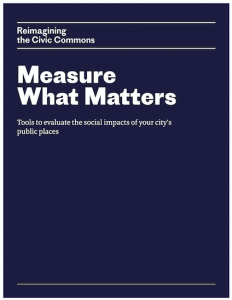A New DIY toolkit helps neighborhoods and cities measure the state of their civic commons
At City Observatory, we’re all about metrics, and especially keen on metrics that help us better understand the function of cities. We’ve mapped everything from the location and changing status of the nation’s neighborhoods of concentrated poverty to identifying the neighborhoods with the highest levels of racial/ethnic and income diversity. We’ve created our storefront index, a kind of quantitative version of Jane Jacobs observations about the way stores, shops and restaurants enliven the streetscape and promote social capital. But we recognize that we’ve just scratched the surface.
There’s much more that can be done on the ground to comprehensively assess how a neighborhood is doing, and to analyze the effectiveness of investments and programs. Our friends at Reimagining the Civic Commons have just released a new toolkit that adds to the growing arsenal that community leaders can use to better measure and understand the state of the public realm. The “Measure What Matters” DIY toolkit.
At the heart of the toolkit are two key elements: observational mapping and intercept surveys. The two elements provide complementary approaches and information to gathering data. Observational mapping is passive and extensive and provides a broad view of activity, while the intercept survey is more active and probes for more detailed qualitative understanding of who’s using public space and why.
The toolkit’s observational mapping section provides worksheets and instructions for systematically collecting data about who visits a site throughout the day, simply by observing. The data include how many people are visiting a site and when, the kinds of activities they engage in, whether they’re interacting with others around them. It also collects demographic data such as age and ethnicity.
The second part of the toolkit is the intercept survey. Here you’ll find an explanation of the methodology for organizing and conducting a reliable survey of site users, gathering data about their demographics, and their attitudes about the place you’re studying. In addition, the intercept survey helps better understand how a particular part of the public realm is used by people who live in different places. Together, the two approaches provide complementary perspectives.
Detroit’s Alexa Bush has an essay at Medium introducing the toolkit and illustrating how its been used to assess neighborhood conditions and opportunities in her city. Bush describes how they’ve deployed the toolkit in Detroit’s Fitzgerald neighborhood, and how it serves as a foundation for building local engagement:
Ultimately, our goal is to involve the community in the major decisions that shape how investment takes place in the neighborhood in ways that equip residents to make these choices. Measuring impact with residents at our side has helped us pivot from fear to defining the concrete problems, challenges and potential solutions that include sharing the benefits of investment and change with the community.
Reimagining the Civic Commons is a multi-year initiative sponsored by a collaboration of national foundations, investing in five U.S. cities to support efforts that revitalize and connect civic assets, and build learning about that process. The initiative is focused on four principal goals: civic engagement, socioeconomic mixing, environmental sustainability and value creation. This toolkit is part of an effort to broaden the project’s impact by sharing the tools developed in these cities
Full disclosure: City Observatory has assisted in gathering and analyzing neighborhood level socioeconomic and demographic data for the Reimagining the Civic Commons project.


